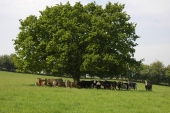I have been reading a lot about silvopasture over the course of the past couple years, because we are trying to reduce ongoing maintenance costs of our highly experimental farm (currently done with weedwackers). Our farm is ten hectares of former cattle pasture that we reforested, by planting about 11,000 trees five years ago. We have primarily tropical fruit trees, and support trees, as well as a handful of timber trees. Our site is located in the high jungle of northern Peru.
I was watching this conference with Ian Mitchell Innes:
https://www.youtube.com/watch?v=27fUjjlwm7U
At about the 1 hour 6 minute mark he shows an image of a (mesquite?) tree in southern Texas and mentions how the high-density rotational grazing ended up contributing to the decline of the tree by changing the soil from a fungal dominated soil to a bacteria-dominated soil.
What do you think of that? Any hard science to back that up, or hard science to refute that? I’ve seen Ian present anecdotal pieces of evidence in some of his other presentations, showing that the management intensive ("mob") grazing favored grasses at the expense of other plant types.
So then, why is it that silvopasture works? Why do natural savannas work? Some of these grazing gurus even talk about the buffalo shoulder to shoulder grazing through savanna areas under trees. What makes a deliberately planted silvopasture tree any different from the Mesquite shown in the above example? If bacterial dominance of the soil created by the management intensive grazing were really a big concern, then what should be done to ensure the health of silvopasture trees in spite of the bacterial soils fostered by livestock grazing?
Ian specifically claims that the tree decline was due to augmenting the Fungal/Bacterial ratio of the soil in favor of Bacteria, and does not suggest that tree decline is a result of mechanical (hoof) damage such as compaction of root zones or direct damage to lateral roots. I know most people blame cows’ weight for killing trees, but such examples are usually where cows are given unrestricted frequent access to the same trees over and over again, not in contexts where a grouping of trees is exposed to cattle for one day and then given two months of rest/recovery.











